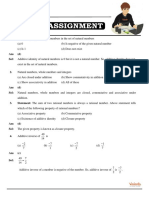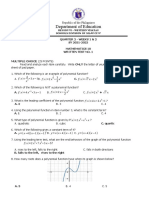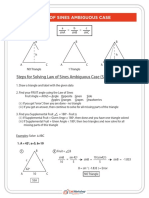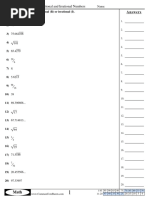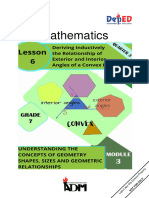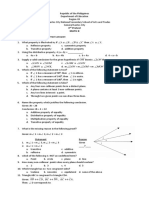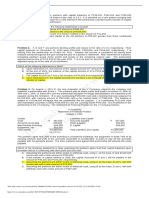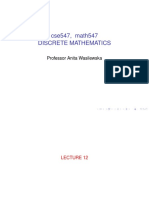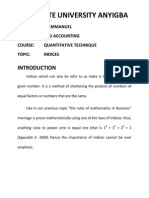Grade 7 Math Lesson 22: Addition and Subtraction of Polynomials Learning Guide
Grade 7 Math Lesson 22: Addition and Subtraction of Polynomials Learning Guide
Uploaded by
Kez MaxCopyright:
Available Formats
Grade 7 Math Lesson 22: Addition and Subtraction of Polynomials Learning Guide
Grade 7 Math Lesson 22: Addition and Subtraction of Polynomials Learning Guide
Uploaded by
Kez MaxOriginal Title
Copyright
Available Formats
Share this document
Did you find this document useful?
Is this content inappropriate?
Copyright:
Available Formats
Grade 7 Math Lesson 22: Addition and Subtraction of Polynomials Learning Guide
Grade 7 Math Lesson 22: Addition and Subtraction of Polynomials Learning Guide
Uploaded by
Kez MaxCopyright:
Available Formats
Grade 7 Math LESSON 22: ADDITION AND SUBTRACTION OF POLYNOMIALS LEARNING GUIDE
GRADE 7 MATH LEARNING GUIDE
Lesson 22: Addition and Subtraction of Polynomials Time: 2 hours
Pre-requisite Concepts: Similar Terms, Addition and Subtraction of Integers
About the Lesson: This lesson will teach students how to add and subtract polynomials using
tiles at first and then by paper and pencil after.
Objectives:
In this lesson, the students are expected to:
1) add and subtract polynomials;
2) solve problems involving polynomials.
Lesson Proper:
I. Activity 1
Familiarize yourself with the Tiles below:
Stands for (+1) Stands for (+x)
Stands for (-1) Stands for (-x)
Stands for (+x2) Stands for (-x2)
Can you represent the following quantities using the above tiles?
1. x – 2
2. 4x +1
Activity 2.
Use the tiles to find the sum of the following polynomials;
1. 5x + 3x
2. (3x - 4) - 6x
3. (2x2 – 5x + 2) + (3x2 + 2x)
Can you come up with the rules for adding polynomials?
AUTHORS: Lambert G. Quesada and Catherine P. Vistro-Yu, Ed.D. 1
Grade 7 Math LESSON 22: ADDITION AND SUBTRACTION OF POLYNOMIALS LEARNING GUIDE
II. Questions/Points to Ponder (Post-Activity Discussion)
The tiles can make operations on polynomials easy to understand and do.
Let us discuss the first activity.
1. To represent x – 2, we get one (+x) tile and two (-1) tiles.
2. To represent 4x +1, we get four (+x) tiles and one (+1) tile.
What about the second activity? Did you pick out the correct tiles?
1. 5x + 3x
Get five (+x tiles) and three more (+x) tiles. How many do you have in all?
There are eight (+x) altogether. Therefore, 5x + 3x = 8x .
2. (3x - 4) - 6x
Get three (+x) tiles and four (-1) tiles to represent (3x - 4). Add six (-x) tiles.
[Recall that subtraction also means adding the negative of the quantity.]
AUTHORS: Lambert G. Quesada and Catherine P. Vistro-Yu, Ed.D. 2
Grade 7 Math LESSON 22: ADDITION AND SUBTRACTION OF POLYNOMIALS LEARNING GUIDE
Now, recall further that a pair of one (+x) and one (-x) is zero. What tiles do you have left?
That’s right, if you have with you three (-x) and four (-1), then you are correct. That means the
sum is (-3x -4).
3. (2x2 – 5x + 2) + (3x2 + 2x)
What tiles would you put together? You should have two (+x2), five (-x) and two
(+1) tiles then add three (+x2) and two (+x) tiles. Matching the pairs that make zero, you
have in the end five (+x2), three (-x), and two (+1) tiles. The sum is 5x2 – 3x + 2.
Or, using your pen and paper,
(2x2 – 5x + 2) + (3x2 + 2x) = (2x2+3x2) + (– 5x + 2x) + 2 = 5x2 – 3x + 2
Rules for Adding Polynomials
To add polynomials, simply combine similar terms. To combine similar terms, get the
sum of the numerical coefficients and annex the same literal coefficients. If there is more than
one term, for convenience, write similar terms in the same column.
Do you think you can add polynomials now without the tiles?
Perform the operation.
1) Add 4a – 3b + 2c, 5a + 8b – 10c and -12a + c.
4a – 3b + 2c
5a + 8b – 10c
+ -12a +c
2) Add 13x4 – 20x3 + 5x – 10 and -10x2 – 8x4 – 15x + 10.
13x4 – 20x3 + 5x – 10
4 2
+ -8x – 10x – 15x + 10
Rules for Subtracting Polynomials
AUTHORS: Lambert G. Quesada and Catherine P. Vistro-Yu, Ed.D. 3
Grade 7 Math LESSON 22: ADDITION AND SUBTRACTION OF POLYNOMIALS LEARNING GUIDE
To subtract polynomials, change the sign of the subtrahend then proceed to the addition rule.
Also, remember what subtraction means. It is adding the negative of the quantity.
Perform the operation.
1) 5x – 13x = 5x + (-5x) + (-8x) = -8x
2) 2x2 – 15x + 25 2x2 – 15x + 25
- 3x2 + 12x – 18 + -3x2 – 12x + 18
3) (30x3 – 50x2 + 20x – 80) – (17x3 + 26x + 19)
30x3 – 50x2 + 20x – 80
+ -17x3 - 26x – 19
III. Exercises
A. Perform the indicated operation, first using the tiles when applicable, then using paper
and pen.
1) 3x + 10x 6) 10xy – 8xy
2) 12y – 18y 7) 20x2y2 + 30x2y2
3 3
3) 14x + (-16x ) 8) -9x2y + 9x2y
3 3
4) -5x -4x 9) 10x2y3 – 10x3y2
5) 2x – 3y 10) 5x – 3x – 8x + 6x
B. Answer the following questions. Show your solution.
1) What is the sum of 3x2 – 11x + 12 and 18x2 + 20x – 100?
2) What is 12x3 – 5x2 + 3x + 4 less than 15x3 + 10x + 4x2 – 10?
3) What is the perimeter of the triangle shown at the right?
(3x2 – 2x) cm
(2x2+7) cm
(x2 + 12x – 5 ) cm
4) If you have (100x3 – 5x + 3) pesos in your wallet and you spent
(80x3 – 2x2 + 9) pesos in buying foods, how much money is left in your pocket?
5) What must be added to 3x + 10 to get a result of 5x – 3?
Summary
In this lesson, you learned about tiles and how to use them to represent algebraic
expressions. You learned how to add and subtract terms and polynomials using these tiles. You
were also able to come up with the rules in adding and subtracting polynomials. To add
polynomials, simply combine similar terms. To combine similar terms, get the sum of the
numerical coefficients and annex the same literal coefficients. If there is more than one term, for
convenience, write similar terms in the same column. To subtract polynomials, change the sign
of the subtrahend then proceed to the addition rule.
AUTHORS: Lambert G. Quesada and Catherine P. Vistro-Yu, Ed.D. 4
You might also like
- Sets of Real Numbers 1 2Document4 pagesSets of Real Numbers 1 2api-350002753No ratings yet
- Different Types of Film AnalysisDocument7 pagesDifferent Types of Film AnalysisKez MaxNo ratings yet
- The Eight Stages of Lectio Divina - Building On A Tradition PDFDocument3 pagesThe Eight Stages of Lectio Divina - Building On A Tradition PDFBeryl BaterinaNo ratings yet
- Rational and Irrational Numbers Part 2 AssignmentDocument3 pagesRational and Irrational Numbers Part 2 Assignmentgobinda prasad barmanNo ratings yet
- Accounts Receivable and Receivable FinancingDocument4 pagesAccounts Receivable and Receivable FinancingLui50% (2)
- Corporate LiquidationDocument2 pagesCorporate LiquidationKristienalyn De Asis33% (3)
- Algebra 2 - Polynomials - End BehaviorDocument8 pagesAlgebra 2 - Polynomials - End BehaviorAYEL FARPARANNo ratings yet
- M y X y y X X M Rise Run y MX+B: Removal Exam 2 Write The Letter of The Best AnswerDocument2 pagesM y X y y X X M Rise Run y MX+B: Removal Exam 2 Write The Letter of The Best AnswerCharina OrtizNo ratings yet
- 2-8 Proving Angle RelationshipsDocument17 pages2-8 Proving Angle RelationshipsKia AlcazarNo ratings yet
- A. Identifying Base Words, Roots, and AffixesDocument2 pagesA. Identifying Base Words, Roots, and AffixesSandra QS MembrereNo ratings yet
- Pre-Test On Addition and Subtraction of Polynomials: Name: Date: Grade 7 - Score: Choose The Letter of The Best AnswerDocument1 pagePre-Test On Addition and Subtraction of Polynomials: Name: Date: Grade 7 - Score: Choose The Letter of The Best AnswerJolly Ann CapalarNo ratings yet
- Grade 6 Unit Test 1 Chapter 1 AlebraDocument8 pagesGrade 6 Unit Test 1 Chapter 1 Alebrazainabnauman821No ratings yet
- TRACK B Module 3 - Polynomial and Rational FunctionsDocument14 pagesTRACK B Module 3 - Polynomial and Rational FunctionsARIANNA YSABEL CHANNo ratings yet
- Triangle Similarity AssessmentDocument2 pagesTriangle Similarity AssessmentSer NardNo ratings yet
- Drawing A Conclusion Worksheet PDFDocument1 pageDrawing A Conclusion Worksheet PDFZoí Melisa Alexopulos Markar100% (1)
- Chapter 7 - 3 - Proving Triangles SimilarDocument10 pagesChapter 7 - 3 - Proving Triangles SimilarHazel Clemente CarreonNo ratings yet
- 9.4 Special Right TrianglesDocument18 pages9.4 Special Right TrianglesAnonymous bOncqbp8yi100% (2)
- Math 10 Q2 WT1Document3 pagesMath 10 Q2 WT1pabsNo ratings yet
- 1-1 Equations of Lines (Notes) PDFDocument3 pages1-1 Equations of Lines (Notes) PDFJulie CoronelNo ratings yet
- Summative Test 1Document4 pagesSummative Test 1Sherra Mae BagoodNo ratings yet
- Factoring Polynomials With Common FactorsDocument10 pagesFactoring Polynomials With Common Factorsjenuhl100% (1)
- Worksheet Chapter 3Document2 pagesWorksheet Chapter 3Manya Elhance100% (1)
- Ambiguous Case WorksheetDocument3 pagesAmbiguous Case Worksheetmszlazak4179No ratings yet
- Gen Math Summative Test 1st QuarterDocument4 pagesGen Math Summative Test 1st QuarterJOSE BENAVENTENo ratings yet
- Module 5 in Math 8Document9 pagesModule 5 in Math 8Dexter CarpioNo ratings yet
- Laws of ExponentsDocument30 pagesLaws of ExponentsAndi IremedioNo ratings yet
- Quotient Rule WorksheetDocument5 pagesQuotient Rule WorksheetAilyn OcomenNo ratings yet
- Angles Formed by A TransversalDocument5 pagesAngles Formed by A TransversalNur ZannahNo ratings yet
- Mathematics 8: Quarter 1, Week 6.1Document12 pagesMathematics 8: Quarter 1, Week 6.1Rock Quel Sotto Daluz-PullosNo ratings yet
- 3.0 Conic Sections Ellipses FCIT CompatDocument29 pages3.0 Conic Sections Ellipses FCIT CompatMykhaela Louize Gumban100% (1)
- Operations On IntegersDocument2 pagesOperations On IntegersPede CasingNo ratings yet
- Converse Inverse and ContrapositiveDocument8 pagesConverse Inverse and ContrapositiveDonita BinayNo ratings yet
- Identifying Rational and Irrational Numbers: I R R I R R I R R R I I I R R R R R I RDocument20 pagesIdentifying Rational and Irrational Numbers: I R R I R R I R R R I I I R R R R R I RRygiem Dela Cruz100% (1)
- Summative Test No. 4Document2 pagesSummative Test No. 4Ser ALNo ratings yet
- System of Linear Equation in Two VariablesDocument30 pagesSystem of Linear Equation in Two VariablesChristian Emman TesoroNo ratings yet
- Geometry Lesson 10 V2 - Converse, Inverse, Contra Positive and BiconditionalDocument11 pagesGeometry Lesson 10 V2 - Converse, Inverse, Contra Positive and Biconditionalezmoreldo100% (2)
- Basic CalculusDocument5 pagesBasic CalculusMaria Fe A DomondonNo ratings yet
- Factoring Completely Different Types of Polynomials: Rhealinda R. BlanqueraDocument54 pagesFactoring Completely Different Types of Polynomials: Rhealinda R. BlanqueraRHEALINDA RAMOSNo ratings yet
- Summative Test Weeks 1-2 - Second QuarterDocument3 pagesSummative Test Weeks 1-2 - Second QuarterAlenie Cornejo ReyesNo ratings yet
- q4 Math Summative Test 1Document2 pagesq4 Math Summative Test 1Jess AnthonyNo ratings yet
- Solving Quadratic Equation by Factoring-Grade 9Document7 pagesSolving Quadratic Equation by Factoring-Grade 9Myrna ConolNo ratings yet
- Module 3 - Polynomial Functions PDFDocument26 pagesModule 3 - Polynomial Functions PDFanamarietuvNo ratings yet
- 6 Rational Expressions and Operations On Rational ExpressionsDocument15 pages6 Rational Expressions and Operations On Rational ExpressionsJanelle Dawn TanNo ratings yet
- Grade-7-Classification of AngleDocument7 pagesGrade-7-Classification of AngleSherlyn Rose AprostaNo ratings yet
- M2L1 - Laws of ExponentsDocument4 pagesM2L1 - Laws of Exponentsdorris09No ratings yet
- Everything About Parallelograms - Squares - Rectangles - RhombusDocument30 pagesEverything About Parallelograms - Squares - Rectangles - RhombusGilbertNo ratings yet
- Summative TestDocument12 pagesSummative TestMaximino Eduardo Sibayan100% (1)
- Name of Teacher Section Leaning Area Time Grade Level Date: Regino A. Yet Elementary SchoolDocument3 pagesName of Teacher Section Leaning Area Time Grade Level Date: Regino A. Yet Elementary SchoolKeyrenNo ratings yet
- CIE 115 Lesson 4Document5 pagesCIE 115 Lesson 4Alexandra Faye Locsin LegoNo ratings yet
- 1.9 Graph Solve Quadratic InequalitiesDocument17 pages1.9 Graph Solve Quadratic InequalitiesMark Abion ValladolidNo ratings yet
- The Midpoint FormulaDocument18 pagesThe Midpoint FormulaChristopher TorresNo ratings yet
- Expectations:: Mathematics 9 Quarter 1 Week 5Document10 pagesExpectations:: Mathematics 9 Quarter 1 Week 5Rodplas PlacerosNo ratings yet
- MathematicsDocument8 pagesMathematicsSkyler MontalvoNo ratings yet
- Points, Lines, and PlanesDocument14 pagesPoints, Lines, and PlanesLorrieanne Oñate Gianan - CamachoNo ratings yet
- Factoring Special Products Worksheet PDFDocument2 pagesFactoring Special Products Worksheet PDFFamesheaNo ratings yet
- TLP 13.1 Addition and Subtraction of Rational Expressions With Different DenominatorDocument6 pagesTLP 13.1 Addition and Subtraction of Rational Expressions With Different DenominatorMilan WanderlandNo ratings yet
- G 8 - 3rd PretestDocument4 pagesG 8 - 3rd PretestHero-name-mo?No ratings yet
- Exponent RulesDocument31 pagesExponent RulesKunimitsu Euxine TezukaNo ratings yet
- Second Periodical Test in Math 8Document5 pagesSecond Periodical Test in Math 8Marjorie SulibranNo ratings yet
- Lesson Plan - Laws of ExponentDocument4 pagesLesson Plan - Laws of ExponentMarizel VillaluzNo ratings yet
- Angle Bisector: Thursday, June 27, 2013Document2 pagesAngle Bisector: Thursday, June 27, 2013Rose Ann AlerNo ratings yet
- Add Subt Polynomials Final TGDocument6 pagesAdd Subt Polynomials Final TGKNo ratings yet
- Grade 7 Math Lesson 23: Multiplying Polynomials Learning GuideDocument6 pagesGrade 7 Math Lesson 23: Multiplying Polynomials Learning GuideKez MaxNo ratings yet
- Internet AdvertisingDocument6 pagesInternet AdvertisingKez MaxNo ratings yet
- Albert Bandura's Social Learning TheoryDocument9 pagesAlbert Bandura's Social Learning TheoryKez MaxNo ratings yet
- A Schema TheoryDocument15 pagesA Schema TheoryKez MaxNo ratings yet
- Examples of Prepositions Used in SentencesDocument4 pagesExamples of Prepositions Used in SentencesKez MaxNo ratings yet
- Cognitive Theory of Multimedia LearningDocument5 pagesCognitive Theory of Multimedia LearningKez MaxNo ratings yet
- Preposition Basics: Prepositions of DirectionDocument3 pagesPreposition Basics: Prepositions of DirectionKez MaxNo ratings yet
- Common Errors With PrepositionsDocument3 pagesCommon Errors With PrepositionsKez MaxNo ratings yet
- Compound Prepositions: Aside From Singing, She Also Plays The Piano at The BarDocument2 pagesCompound Prepositions: Aside From Singing, She Also Plays The Piano at The BarKez MaxNo ratings yet
- DocxDocument9 pagesDocxKez MaxNo ratings yet
- Ending A Sentence With A PrepositionDocument2 pagesEnding A Sentence With A PrepositionKez MaxNo ratings yet
- National Mock Board Examination 2017 Auditing: A. Consolidated Net Profit After Tax Attributable To ParentDocument13 pagesNational Mock Board Examination 2017 Auditing: A. Consolidated Net Profit After Tax Attributable To ParentKez MaxNo ratings yet
- This Study Resource Was: Partnership LiquidationDocument3 pagesThis Study Resource Was: Partnership LiquidationKez MaxNo ratings yet
- This Study Resource Was: Consignment SalesDocument3 pagesThis Study Resource Was: Consignment SalesKez MaxNo ratings yet
- Problem 1: Total Assets 937,500 Total Liab &she 937,500Document14 pagesProblem 1: Total Assets 937,500 Total Liab &she 937,500Kez MaxNo ratings yet
- This Study Resource Was: Quiz On Receivable FinancingDocument3 pagesThis Study Resource Was: Quiz On Receivable FinancingKez MaxNo ratings yet
- Accounting For Business TransactionsDocument8 pagesAccounting For Business TransactionsKez Max100% (1)
- This Study Resource Was: Assets Liabilities and CapitalDocument3 pagesThis Study Resource Was: Assets Liabilities and CapitalKez MaxNo ratings yet
- Chapter 1 Standard FormDocument14 pagesChapter 1 Standard FormThiyaku MaruthaNo ratings yet
- Multiplying Floating Point NumbersDocument8 pagesMultiplying Floating Point NumbersMikaelYuruBeliNo ratings yet
- Solution DPP Binomial Theorem BITSAT Crash Course MathonGoDocument9 pagesSolution DPP Binomial Theorem BITSAT Crash Course MathonGolol344466No ratings yet
- Error Detection and Correction.1Document31 pagesError Detection and Correction.1Aliya GNo ratings yet
- Ratio, Proportion & Variation: N M N M N MDocument92 pagesRatio, Proportion & Variation: N M N M N MsamdhathriNo ratings yet
- Algebraic SimplificationDocument5 pagesAlgebraic SimplificationJalaj ChaturvediNo ratings yet
- Mat 1Document18 pagesMat 1ArpitNo ratings yet
- Chap 0Document31 pagesChap 0Mỹ VânNo ratings yet
- Chap6 - Engineering Measurements and EstimationsDocument36 pagesChap6 - Engineering Measurements and EstimationsalsinanhananNo ratings yet
- Cao Lab ManualDocument64 pagesCao Lab ManualmintuNo ratings yet
- New Lec 12Document82 pagesNew Lec 12Monir HossainNo ratings yet
- Part A: Alethea International School 2Nd Term Test - March 2022 Mathematics Grade 6IDocument4 pagesPart A: Alethea International School 2Nd Term Test - March 2022 Mathematics Grade 6IsupunizzzNo ratings yet
- Number Theory Revision - 2Document5 pagesNumber Theory Revision - 2pv71705No ratings yet
- 10th Maths Ch-1 Practice MaterialDocument4 pages10th Maths Ch-1 Practice Materialradhikakamra95No ratings yet
- School Grade LevelDocument4 pagesSchool Grade Levelrina galayNo ratings yet
- Numbering Systems, Decimal, Binary, Hexadecimal and ASCII: Position NotationDocument26 pagesNumbering Systems, Decimal, Binary, Hexadecimal and ASCII: Position Notationkndnew guadeNo ratings yet
- Digital Logic Design Lab Manual Fall 20 Semester Version 4Document78 pagesDigital Logic Design Lab Manual Fall 20 Semester Version 4Abdul HaseebNo ratings yet
- Binary SubtractorDocument8 pagesBinary SubtractorJohn Brix BalisterosNo ratings yet
- Class 7 Hand Notes On Number System 1 1Document6 pagesClass 7 Hand Notes On Number System 1 1zannateen nayeem100% (1)
- Revision Material CLASS X MATHSDocument111 pagesRevision Material CLASS X MATHSjatinrNo ratings yet
- 09 DLD Lec 09 Binary Codes Dated 13 Apr 2022 Lecture SlidesDocument8 pages09 DLD Lec 09 Binary Codes Dated 13 Apr 2022 Lecture SlidesAbdullah TahirNo ratings yet
- Grade 7 MathDocument17 pagesGrade 7 MathJeffrey ConchaNo ratings yet
- Admmodule Stem Gp12eu Ia 4Document25 pagesAdmmodule Stem Gp12eu Ia 4Weaknightz RaijinNo ratings yet
- Byjus Com Maths Important Questions Class 10 Maths Chapter 1 Real NumbersDocument15 pagesByjus Com Maths Important Questions Class 10 Maths Chapter 1 Real Numbersgd041098No ratings yet
- Laws of IndicesDocument4 pagesLaws of IndicesstephenidahNo ratings yet
- QUESTIONNAIREFORTOS1Document5 pagesQUESTIONNAIREFORTOS1Joan CamporedondoNo ratings yet
- Height ProjectDocument9 pagesHeight ProjectAnvi bNo ratings yet
- Dar Es Salaam Institute of Technology Assignment 1F Algebra (GST 04101) Od20 ItDocument5 pagesDar Es Salaam Institute of Technology Assignment 1F Algebra (GST 04101) Od20 ItICONIC ENTNo ratings yet
- General Math QuizDocument5 pagesGeneral Math QuizHania PindatonNo ratings yet



